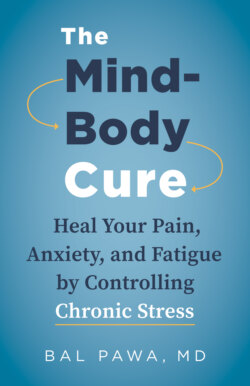Читать книгу The Mind-Body Cure - Bal Pawa - Страница 45
На сайте Литреса книга снята с продажи.
➤ Train Your Brain
ОглавлениеCreating a health mindset uses the principles of neuroplasticity to emphasize the relationship between learning and “brain training.” Just like any muscle, we can train our brain by doing “mind reps.” The key to forming new neural networks is to observe our patterns of inner dialogue and change our vocabulary from criticism and judgment to encouragement and compassion. I find it helpful to start my day by setting an intention to mindfully catch and observe my thoughts. At least eight to ten times each day, I try to become aware of my automatic pathways and consciously change my vocabulary if it is negative. For example, I might try to use the word “learning” instead of “failing.” If you are struggling, you could use the phrase, “I haven’t mastered a health mindset yet,” inferring that with time it will happen. “Not yet” is a wonderful way to reassure the brain that we are making progress. Discerning the phrase “room for improvement” from “failure” helps our inner critic be more encouraging and compassionate.
When we practice mindful meditation, we allow the mind to go quiet. As we observe our thoughts, we gain more conscious control over what thoughts we allow. The relaxed brain becomes more receptive to new learning, because neuroplasticity is more effective when the mind and body are in rest-and-digest mode.7 Meditation alters our neural chemistry, transforms our electrical brain waves, and enhances blood flow to areas of the brain that encode memory. All of these conditions are perfect for embedding new behaviors.
Counseling tools such as cognitive behavioral therapy (CBT), neuro-linguistic programming (NLP), emotional freedom technique (EFT), and many other reframing techniques are available to help us gain more control over our emotions. CBT is used to help people with a variety of mental health disorders overcome distorted thought patterns (cognitive) and impact their actions (behavior). NLP is a therapy that connects neurological processes, language, and behavior patterns to create change to meet specific therapeutic goals. EFT is a therapy that brings together a variety of alternative medicines, including tapping and energy, to treat both physical and psychological disorders. Tapping specific acupressure points seems to allow some patients to regain control of the disordered brain waves associated with anxiety. That is, EF T aims to understand the subconscious thoughts and beliefs that underlie our choices, so we can ensure they are beneficial to our health.
The key to all of these techniques is that by understanding how and why our negative thoughts arise, we can consciously replace them with new patterns of thinking. When we do this frequently and repetitively, the new thought patterns become automatic neural circuits that benefit our brain, our ANS, and our overall health and well-being. Although CBT is quite well established, most psychiatrists do not yet fully endorse NLP and EFT, and more data and research will be needed before they are widely used. However, their ability to address subconscious beliefs as well as conscious ones makes them interesting areas to explore, and many patients have already benefited from these techniques.
Learning is the “journey” and more important than the destination. If we emphasize learning well over learning fast, we garner better results. Reinforce the new learned behavior by using reflection techniques to embed the “good stuff” and enhance the memory. Take the time to replay positive emotions such as pride and inspiration and to re-experience the situation using all your senses. The more often we choose to self-accept, self-approve, and self-appreciate, the more that behavior becomes part of our internal hard drive. Thus, we need to reward the actions we have taken, not the thoughts we passed through our brain.
